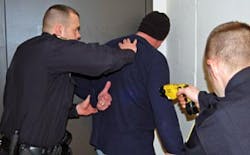It really comes down to those two options - either the suspect will cooperate by way of listening to reason or the application of force. Either they go willingly or you and possibly other officers take them under control. Sometimes it's a combination. A seemingly cooperative suspect will suddenly resist or attack. Likewise, a suspect bent on resistance will cooperate based on a display of force. But those two options - reason and force are at the center of suspect encounters.
That means that you have to be good at the application of both on the street.
Reason and Reasonableness
Conveying reason to suspect(s) via tactical communications is crucial to officer safety and survival. It is simply not tactically sound to be confrontational. It leads to more aggression not less which results in more frequent uses of force and possible injury and increases the possibility of citizen complaints of rudeness.
It is my belief that many instances of officer's verbal loss of control are attributable to inability to handle the fight or flight reflex. The officer is unfamiliar or cannot deal with the Sympathetic Nervous System (SNS) reaction (fight or flight) and the resultant chemical cascade that takes place within the brain and body. Quite simply they get amped up and shoot their mouths off. As an example most times you simply can't out yell a yelling person into cooperation.
Tactical communications first of all mandates control on your part. Imparting a professional and non-aggressive demeanor does much to reduce aggression and tension. This is not to confuse readiness with non-aggression. Since the majority of communication is non-verbal you must project that you are indeed capable and ready to use force if necessary but you're under control.
For instance, you're arresting a suspect who is actively resisting at a shopping mall in front of a group of citizens. Blitzing that person with knee strikes to the outside of the thigh while communicating, "Stop resisting! Get on the ground!" is more likely to result in no complaints than profanity laced commands.
Control of the SNS response is based to a large extent on experience. Maintaining control of your psychological, emotional and physical responses to fear comes from understanding that these changes take place in your body and immediately controlling them via breathing and focus. Realistic training can take your body and brain there and teach you how to control your responses to stress. Street experiences if dissected via a lessons learned format (internally if it's just you or a group debrief if more officers are involved). If you or others make mistakes either tactically or via communications and don't learn from it, you're apt to repeat the same mistake again.
Of course, it's tough to reason with a drunk, mentally ill person or someone under the influence of drugs but we can write in our report that we tried and it just wasn't effective. That makes us reasonable as defined by the law. We tried non-violent means; we gave the suspect an out; we attempted to verbally persuade them to comply - they just didn't do it and they gave us no other option but to use force.
Even if it seems that talking a suspect into cooperation comes across as wimpy, remember - if it elicits control and defuses potential violence and you get to go home without injury... it's a streetwise tactic.
Tactical communication is the carrot; use of force is the stick.
Force
The majority of subjects and suspects we come into contact with comply. They comply with our verbal orders or with our display of force but we must always train and prepare for those that do not. We must be good at applying force. We get hurt or worse when we are not good at using force.
Being good at force means all facets and manner of force. Good at joint-locks, pressure points, empty hand striking, applying pepper spray, using a baton or electronic control device and it certainly means that we must attain and retain competency with deadly force. We must practice and maintain proficiency at getting our firearms into play and being able to achieve fight stopping accuracy on target. Being good at force cannot and will not be achieved only by department defensive tactics training or firearms qualification events. Qualifications are a display of minimum performance levels not an indicator of readiness. Sorry folks, if you want to be good at hitting, sticking or shooting you must invest your own time and effort in a serious training regime to achieve it. There are no easy ways or short cuts.
Regardless of the vocation, professionals read, study and prepare for their business. They anticipate, pay attention to trends, are attuned to warning signs, and are ready with pre-practiced responses. Law enforcement professionals are able and capable of communicating with a suspect and establishing control through non-violent means but they are also masters of the physical aspects of the job. Armed with the tools and prepared to apply force to control they are ready for the most violent of resistors.
Whether you're presence on scene in uniform is enough to elicit control of a situation or whether you must strike a suspect, at the root, it is either reason or force that makes it happen. Train and prepare for the application of both because it is the suspect's threats of attack or resistance or our perception of attack/resistance that directs our pre-emptive or responsive police actions.
About the Author
Kevin Davis
Tactical Survival Contributor
Kevin R. Davis retired from the Akron Police Department after 31 years with a total of 39 years in law enforcement. Kevin was a street patrol officer, narcotics detective, full-time use of force, suspect control, and firearms instructor, and detective assigned to the Body Worn Camera Unit. Kevin is the author of Use of Force Investigations: A Manual for Law Enforcement, and is an active consultant and expert witness on use of force incidents. Kevin's website is https://kd-forcetraining.com/

